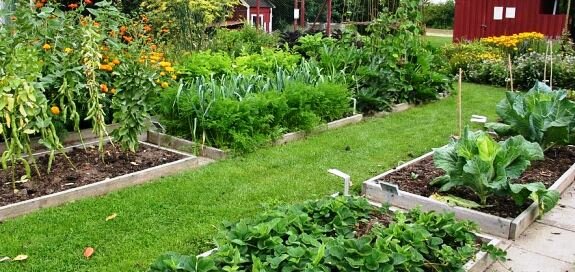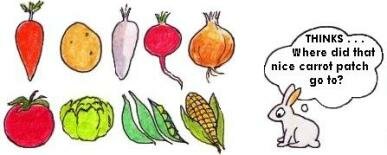Crop Rotation
Succession Planting in your Vegetable Garden
A key to successful gardening is crop rotation. It's not the latest dinner party gossip, it's old hat. So be a smart cookie and do what nature does (there I go on about nature again)!
Different plants take different nutrients out of the ground soil and add back other elements or enhance the soil in other ways. To prevent your garden from becoming less productive from season to season, crops are rotated.
Importantly, crop rotation allows you to naturally interrupt the life cycle of pests and diseases so they cannot become established.

Of course this applies only to annual plantings, not the perennial plants, such as asparagus.
Plant succession happens naturally, whether it be caused by a landslide, flood, or a freshly bulldozed area. First onto the scarred soil grow the aggressive weeds which hold it together and stop wind and rain from denuding it further.
Usually the next invaders lurking under the weed cover are matted rambling plants. They guard the ground and may have thorns, as though to warn, "Sorry, you can’t come in here now, but never mind, have some berries!"
The next succession, under protection from the elements come the fast growing trees, followed by the re-establishment of the full forest many decades later. It's a natural succession, each succession benefitting from the previous plants.
In our gardens we have a less elaborate but more specific plan. As with nature, which will quickly cover soil with plants, what we do is to choose the plants which will bring us the most benefits.
Rather than letting weeds spring up, we plant either a fallow or cover crop to tide us over to the next season and replace lost nutrients that the previous crop took out, or we plant another useful vegetable crop that utilises different nutrients and growing conditions than the previous crop.
Mamma Colorado beetle got blown over 'n over and landed down the street into.. wow, her wildest delight, an eggplant patch. She laid lots of eggs and the baby larvae chomped on the leaves. The babies dropped into the soil to pupate, slept in and suddenly it was spring again. Time to get up, but where's breakfast? Why has Mum given us spinach? We don't like spinach, we want eggplants... waaa... keel over and die...

And of course, if you have the misfortune of getting blight in your spuds, onion worm in your onions, and other flapadoodle dandies dicing your veggies, then you simply must not grow those veggies in the same space again for many years.
It's better to rotate veggies to prevent any trouble happening in the first place, but you can quickly stop any rogues in their tracks by careful management thereafter.
Separate the garden into sections. Anything from 4-8 areas is ideal. They can be part of one bed, or they can be a group of beds, it doesn't matter. Visualise it, draw it down, mark it out — or do what you need to get the picture of how it will work in your garden.
Many gardens are higgledy piggledy plots of soil here and there, or odd shapes, so don't worry about doing the perfect diagram.
What does matter is that you rotate the crops around the beds systematically. The rule of thumb for crop rotation is counter clockwise... don’t ask me why... funny lot us gardeners!

The suggestions here will be put in very broad terms. It is impossible to predict every combination of vegetables that you will want to grow, but the principles are fairly straight forward.
Plant Requirements
There are roughly 3 main classes of plants when talking about their requirements. They are:
-
Heavy feeders: These need lots of fresh rich fertiliser (compost, reasonably aged manure and liquid manure etc ) and can be planted immediately into this fertilised soil.
These heavy feeders are all leaf vegetables like head lettuce, spinach, brassicas such as cabbage and cauliflower, chard, endive, as well as celery, leeks, sweet corn and vines particularly cucumbers and squash. Rhubarb is a heavy feeder, but does not need to be rotated because it is a perennial.
Tomatoes, another heavy feeder, are decidedly odd in that they like to grow in the same spot each year and somehow build up resistance to problems. This is handy because you can utilise that nice warm spot by the fence for example, each season... but you must make sure you pile on plenty of fresh compost each year.
- Soil conserving and improving: Legumes such as peas and beans, and cover crops, often called fallow crops are perfect to follow heavy feeders. These are plants give the soil a bit of a rest, as well as returning some nitrogen and fiber to the soil when they are incorporated into the ground by way of mulch or compost before the next crop.
- Lighter feeders: They still love that compost, but it must not be fresh otherwise they will grow rank and coarse. So well-aged fertiliser suits such plants as all bulb and root crops like carrots, radishes, beets etc. Parsley with its long tap root, and many herbs also fall into this aged compost feeding class.
What about the families?
Ah yes, like us they can wear each other out!
Horticulturally, it’s because plants from the same family tend to have the same nutritional needs and can exhaust the soil of particular elements if continually planted in succession. They can also attract the same problems which can build up alarmingly unless the family members do a recommended split.
Out of thousands of plant families, here are the most familiar ones:
MONOCOTS
Grasses (Gramineae), like cereals and corn.
DICOTS
Mustard Family (Cruciferae). Cold loving plants, such as brassicas like cabbage, kale, bok choy, collards like kohl rabi and turnip, etc. Also radish and cress.
Pea Family (Leguminosae). These include peas, of course, and beans plus vetch, lentils and lupins.
Carrot Family (Umbelliferae). Lots of long root crops here, like carrots, parsnips, parsley, celeriac, fennel, chervil, and the root herbs.
Goosefoot Family (Chenopodiaceae). A mixture here, such as beets, swiss chard and spinach.
Nightshade Family (Solanaceae). The well known potato and tomato plants. Also eggplant, chillies and peppers.
Gourd Family (Cucurbitaceae). Warm loving plants such as melons, pumpkins, squashes and other gourds.
Composite Family (Compositae). So called because of their complex composite flowers, they include endive, witlof, sunflower, Jerusalem and globe artichoke, salsify and some herbs like dandelion, yarrow and chamomile.
A few of the many other plant families include the Buckwheat Family (Polygonaceae) which has rhubarb; the Morning Glory Family (Convolvulaceae) which supplies us with yams, kumara and sweet potatoes; the Mallow Family (Malvaceae) supplying okra; the Carpet Weed Family (Aizoaceae) giving us New Zealand spinach; the Rose Family (Rosaceae) with most fruits and berries including strawberries: and the Mint Family (Labiatae) which include mint, sage, oregano, marjoram, thyme, rosemary, basil, lemon balm, savory, bergamot and many other herbs.
Time for a tour of your garden to work all this out... or better still to sit down and write a plan. It's helpful, especially if you are just starting out, to make notes and keep a record of what you do.
It soon becomes natural for you to rotate your plants, making small adjustments to arrive at perfection (you wish!).
Briefly to start, plant like with like. Divide your plants into families because they need broadly similar conditions and they generally get along together. The odd exception is usually because of pests and disease challenges, such as Potatoes and tomatoes, whereby tomatoes attract potato blight. Read Companion Planting.
Prepare each area for what it is expected to grow. Leafy heavy feeders like an early and continuous feast; most root crops like an alkaline soil and hold back on the manure and fresh compost.
Tomatoes and eggplants like a more acidic soil, with plenty of feeding and aged manure.
Legume crops love well aged compost and a few light feedings to follow. They will leave the soil loaded with nitrogen which sets the bed up perfectly for brassicas and leafy greens to follow.
~~~~
Dear Gardening Reader – Do you need a gift for someone special?
Try Garden Gift Hub for affordable and interesting
nature inspired products.
~~~~
For most home gardeners it's nigh impossible to do crop rotation 100%. So be content with succession planting on a small scale and for generally watching out for potential hazards. Club root in brassicas is one that comes to mind — it's hard to avoid if you don't rotate those brassicas, especially if you buy in seedlings or accept some from a friend.
Sample outline of crop rotation
So a typical sample 4 bed rotation might look like this:
Bed 1: Root Crops, onions
Bed 2: Legumes (peas, beans), brassicas (broccoli, cauliflower, cabbage, Brussels sprouts)
Bed 3: Tomatoes, eggplant, capsicum (peppers)
Bed 4: Sweet corn, curcubits (cucumber, melons, pumpkin)
A 6 bed rotation might look like this:
Bed 1: Legumes
Bed 2: Brassicas
Bed 3: Root crops, carrots, parsnips, potatoes
Bed 4: Corn, curcubits
Bed 5: Tomatoes, capsicums, eggplant
Bed 6: Green manure crop
Don't be too rigid in your classifications if you don't have enough room to make clear demarcations. Just make sure you keep it moving season after season or at least every 2-4 years.
RELATED SUBJECT: Companion Planting in the vegetable Garden
HOME page: No Dig Vegetable Garden





